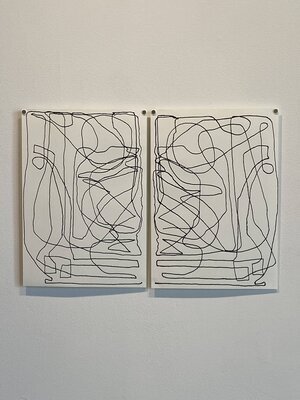Other Self
ROY presents: Amery Kessler
Fri, Jun 12, 2020 - 6:00 PM
Sat, Jul 4, 2020 - 3:00 PM
My relational work grew out of a practice of painting and drawing. My process was based on predetermined rules and chance operations and explored how a painting could be a record of events. I found ways to exclude the evidence of my personal hand or my story and was mainly interested in the most fundamental ways we perceive space, surface, and scale. At this time, my approach was almost gamelike. The rules or guidelines I set for myself began to include the participation of others. I was curious about the simple or not so simple act of viewing a painting. If a painting is a collaboration of the maker and the viewer, and two people are looking at a painting, how many paintings are there? Of course, there is one object, but I was curious about the significance of how each person’s context, their personal interpretation or insight, played a role in the assumptions of relating with each other.
The experience or encounter of two or more people, of self and other, became central to my current work. The objects are designed to serve as the means for a shared experience of differentiation and unity. Presented without active participation, they represent the dynamics of interpersonal encounters. They imply the proximity of people to each other and take into account the role and design of space. The forms are simultaneously a barrier and a place for connection. The coinciding events or actions are specific, in a sense also rule based, and become temporary social agreements for people to interact in a familiar yet unconventional way. The actual or implied participation is not simply about accomplishing work, playing an instrument, or winning a game. The participants are not performers in the typical sense of accomplishment or entertainment. The action or objective of hammering a peg, plucking a string, or moving a game piece, is purposefully confusing or unusual. In this way, I am considering or humoring how the form of an encounter or relationship can be significant in and of itself.
AMERY ANSWERS THE QUESTIONS ROY ASKS
WHAT IS YOUR NAME AND WHAT PRONOUNS DO YOU USE?
Amery Kessler He/Him
WHAT MEDIUM(S) DO YOU WORK WITH AND WHY?
There is a range. More than a specific medium there is an ongoing theme of asking questions about and representing the opportunity for encounters. Sometimes the materials are familiar from other experiences in my life, such as playing music or working construction, sometimes the material choices reference other artists’ or writers’ work.
HOW DID YOU BEGIN YOUR ARTISTIC PRACTICE?
I grew up in a family that encouraged creativity, art, and building things/taking things apart. The way I’m working now began with looking at moments of my life that I valued most yet hadn’t incorporated into a practice of research and making etc. I found I had a lot of gratitude for the way I spent time with people, inventing ways to pass time—moments where the presence of the encounter made as big of an impression as the goal or productivity of spending time together.
WHO/WHAT ARE SOME OF YOUR BIGGEST INFLUENCES OR INSPIRATIONS?
This answer changes as I reflect on my work differently—sometimes I uncover an influence that had been hiding or laying low. Today, the biggest inspiration I notice is a desire to be both social and isolated, to find a personal way of digesting or housing big ideas while also being free from identifying with thought. I find a lot of encouragement by discovering and learning from artists and writers who’s work resonates with my curiosities or struggles, but almost always the initial inspiration, for me, is unexpected coincidence—when seemingly different worlds or disciplines entangle or harmonize.
YOUR WORK SEEMS TO FOCUS ON ARCHITECTURAL SPACES OR MOTIFS. IS THIS CONSCIOUS? AND WHAT KIND OF DIALOGUE ARE YOU IMPLYING?
One conscious thought that seems especially relevant today is the use of glass. The production of glass especially in terms of strength and scale, its use in architecture, gives people the illusion or appearance of access to space while actually being a barrier. It has changed the use of and prevalence of mirrors immensely. It has absolutely changed the way we see ourselves as well as our capabilities of building telescopes that essentially shorten the greatest imaginable distances. Glass—to me, has been a fluid yet concrete material, capable keeping people apart while bringing them together.
WHAT KINDS OF INTERACTIONS DO YOU HOPE TO FOSTER BETWEEN YOUR WORK AND THE VIEWER?
Often these works are participatory. I hope that in this instance of being on view only, the viewer could see the work as a place where people meet, where one person encounters another, or where one person is both removed from a group and the center of attention.
WHAT ARE YOUR THOUGHTS ON THE INTERPLAY BETWEEN THE ARTIST AND THE AUDIENCE?
In some ways, the distinction is blurred. Once the work has been developed and set in motion, I enjoy being on a more level plane as one of the audience or participants. On the other hand, as the maker or instigator, I am careful about my intentionality and appreciate when people participate in a way that honors the vision.
Commission available upon request. Artists receive 65% of sales and the 35% ROY retains is invested back into the gallery.
top row left > right Documentation of Other Self; Other Self; Mirror Drawings; Dollar and Dollar Hole;
Double Monochord; Drum Casket; Drum Casket Hole; Mirror Chess;
View more of Amery’s work here








